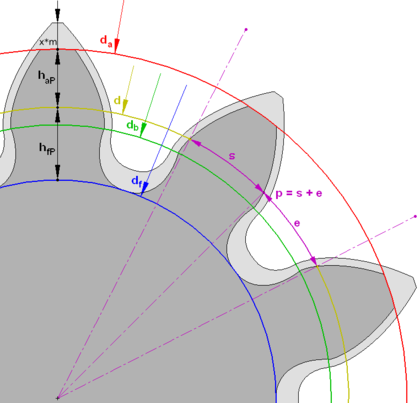Profile shift
Profile shift is a term from the gearing and transmission theory ( gearwheel ).
Gears can be designed and manufactured with a profile shift. The shape of the teeth is changed, but without changing the underlying basic curve: In a gear with a profile shift, a different part of the same curve (usually involute or cycloid ) is used as the tooth flank compared to a gear without a profile shift .
Terms
In the case of involute gearing , the profile shift can be specified as a radial dimension and is then the path that the rolling tool is fed less deeply or deeper. refers to the module of the toothing and the (dimensionless) profile shift factor . The profile shift factor is usually between −1 and +1.
With a positive profile shift, the tool is shifted in the direction of the tip circle. In the case of external teeth, there is a positive profile shift towards the outside, in the case of internal teeth, inward.
Positive profile shift for external gears
- The part of the involute used is shifted outwards.
- A less strongly curved part of the involute is used as the tooth flank
- The tooth tip becomes thinner, the tooth base thicker
- During production, the tool is infeed less deep.
The opposite applies to a negative profile shift.
Positive profile shift for internal gears
- The used part of the involute shifts inwards.
- A more curved part of the involute is used as the tooth flank.
- The tooth tip becomes thicker, the tooth base thinner.
- During production, the tool is advanced further to the outside.
While a positive profile shift generally has a positive effect on the load-bearing capacity with external gears, the opposite is true for internal gears. For this reason, external gears are mainly designed with positive and internal gears mainly with negative profile shift.
For gears other than involute gearing, a radial profile shift cannot simply be specified, since the special relationship between the tooth contour and the pitch circle must be maintained. Therefore, a simple change in the center distance with the same module (or adaptation of the module with a given center distance) is generally not possible. The profile shift then corresponds most closely to a widening of the teeth of a gear in the circumferential direction, which must be absorbed by a corresponding narrowing of the engaging gear.
Use of the profile shift
A profile shift offers the following advantages:
- Axial distances required for construction can be maintained with the standardized modules
- A positive profile shift usually results in a higher tooth root and pit load capacity ("stronger" teeth)
- The load capacities can be adjusted by choosing the distribution of the profile shift factors between pinion and wheel
- An undercut can be avoided by a positive profile shift
When hobbing involute gears with a small number of teeth (<17), an undercut occurs . This means that the hob cuts away part of the supporting involute at the tooth root, which means that the mating gear can no longer run smoothly. This can be avoided very easily by a positive profile shift.
The limit value for undercut for the standard reference profile according to DIN 867 is 17.1 teeth (theoretical). In other (non-rolling) processes, e.g. B. with wire EDM or with conventional milling and grinding, this undercut does not occur.
The influence of the profile shift on the shape of the tooth is very large with small numbers of teeth, but hardly noticeable with large numbers of teeth (> 100 teeth).
In the case of profile-shifted gears (often also referred to as "corrected gears"), the tip diameter and the root diameter change by 2 * x * m (note the sign of x).
- d a = m * (z + 2) + 2 * x * m
- d f = m * (z - 2 * 1.25) + 2 * x * m
(applies to straight toothed gears with reference profile II = hap0 = 1.25 * m)
| Advantages of profile shifting with external gearing | Disadvantages of the profile shift with external gearing |
|---|---|
| positive profile shift | |
| The tooth root becomes wider (higher strength) | The tooth tip becomes narrower, possibly very pointed (teeth must never be completely pointed, risk of cracking during hardening , risk of breakage) |
| negative profile shift | |
| The tooth head becomes wider | Weakening of the tooth root, an undercut can occur (part of the tooth flank is cut away during production) |
Gear pairings (outdated)
- Zero toothing : no profile shift
- V-zero toothing : the profile shift has the same amount for both gears with a different sign
- V-serration : the shift is arbitrary (only here a change of the center distance is possible)
Types of wheels (obsolete)
- Zero gears: no profile shift, profile shift factor x = 0
- V-plus wheels: positive profile shift towards the outside. The pitch circle d 0 remains the same, tip circle d a and root circle d f increase.
- V minus gears: negative profile shift , inward. d 0 remains the same, tip circle d a and root circle d f decrease.
literature
- Verzahntechnik Lorenz GmbH & Co. (Ed.): Gear tools . 3. Edition. Ettlingen 1977, ISBN (not available).
- Heinz Linke: Spur gear teeth . Carl Hanser Verlag, Munich 1996, ISBN 3-446-18785-5 .
- G.Niemann, H.Winter: Machine elements volume II, gear transmission basics . Springer Verlag Berlin, Heidelberg 1989 ISBN 3-540-11149-2 .



